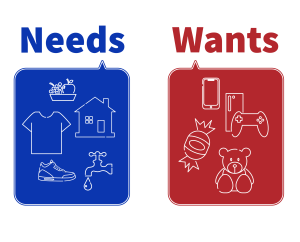2.1 Buying 101
Example: Shopping

You walk into an Abercrombie & Fitch store at the mall, and without thinking about it, you turn to the right and make your way through the denim, past the belts, and to the sweaters. You are so engaged in the experience that you didn’t even realize that the huge mural at the entrance to the store serves a purpose other than to make you look twice at the model in the larger-than-life photo. Before you know it, one of the salespeople dressed in Abercrombie from head to toe approaches you with a smile. “These hoodies are awesome,” they say as you pick up the pale blue one.
Shopping. It’s the national pastime for some but a detested necessity for others. Whether you love shopping or do everything to avoid it, it is a major source of spending in North America. In fact, the retail industry generated $14.795 trillion in sales in 2019 (yes, trillion) (Bureau of economic analysis, 2020). That’s a lot of selling—and a lot of buying. But what makes you buy a pair of jeans you weren’t even looking for? What makes you walk out of the store spending more than you had planned (Consumers usually spend more than they planned) (Petro, 2019).
Inside Consumer Behaviour
The science of consumer behaviour describes and even defines how you shop and, more importantly, why you buy. Smart retailers study consumer behavior patterns and lay out their stores and merchandise accordingly. For example, did you know that 86 percent of women look at price tags when they shop, while only 72 percent of men do? (Proctor, 2017). And did you know that the average shopper doesn’t actually notice anything that’s in the entrance of a store? According to Paco Underhill, CEO and founder of EnviroSell, and author of the book Why We Buy: The Science of Shopping, consumers do not actually begin shopping until a certain point after they enter the store. That is why smart retailers include a “transition zone” at the entry to their store; it allows customers to get their bearings and choose their shopping paths. In other words, products, signs, and displays that are in the very front of the store might not be seen if there is not a transition for the customers when they enter.
In the case of Abercrombie & Fitch, the transition is the space just inside the entrance that includes the humongous photo of the Abercrombie model du jour. When you go into Hollister, it is the outside porch that serves the same purpose; it is a transition that allows you to get your focus and plot your course in the store, even if you do not consciously realize it. Think about the last time you went into a grocery store or drug store; you might not have noticed anything until you were well inside the store, which means that the merchandise and signs that were displayed in the area before you got your bearings were virtually invisible to you (Underhill, 1999). Subconsciously, you adjust your eyes to the light, process any smells and sounds, notice the temperature, if it is busy and the general layout of the store when you first enter before you think about the actual shopping (Stephenson, 2019). “Rather than waste the space with a cluttered front entrance that has little chance of being noticed, it’s better to create an effective transition zone” (Stephenson, 2019, para 9).
Understanding how and why customers buy can make a significant difference in how you sell. Is the product a considered purchase, like a computer or car or an impulse buy, like a sweater or music download? Is the product bought frequently, like an energy drink, or only once every few years or even once in a lifetime, like a car or a college education? For each of these products, the customer goes through a buying process. Understanding the customer and the buying process can make your selling efforts successful.
Do You Need It or Want It?
Think of something you need, like an annual medical checkup, a new apartment because your lease is up, or even food to survive. There are some products and services you purchase solely because you cannot exist without them. Now think about something you want: a new pair of jeans, an iPhone, and tickets to a concert. There is a significant difference in what motivates you to buy products and services you need, compared to those you want.
To avoid appearing forceful and thoughtless, which may not lead to a successful sale, it is crucial to comprehend your customers’ wants and needs before promoting your product. Adopting a customer-focused approach can enhance your efficacy and help you secure more deals (Martinello, 2021).
Why This Matters
It will be more likely that your customer will end up purchasing your product if it meets a core need, but more importantly, satisfies their wants (Martinello, 2021). Remember the last purchase you made? Whatever it was, it had something you always “wanted”. Be it shoes with a fabulous design or any body-wash with a specific fragrance, you consciously chose to reject similar products that didn’t possess the specific qualities you most wanted. Having a thorough comprehension of your customers’ wants not only simplifies the process of selling them what they require but also enhances your effectiveness in doing so.
Needs versus Wants

Needs are essentials, those products and services you literally cannot live without. Food, shelter, clothing, transportation, and health care are all examples of needs. Wants, on the other hand, are products, services, and activities that can improve your quality of life; you don’t need them to exist, but rather you desire to have them because you think they will make you happy (Biekkola, 2009). Cell phones, vacations, sporting events, restaurants, amusement parks, cable television, and fashion are all examples of wants. People are motivated differently depending on if they are making a purchase for a need or a want. Could you see how cellphones could be argued as a need and a want?
Needs and wants have different motivations. Think about buying a computer; you could focus on the functional attributes of the car such as miles per gallon, maintenance costs, and safety ratings. Functional attributes fit within utilitarian needs –those needs that are necessary (Das et al., 2018). So, if those were your only needs, you might choose a Smart Fortwo, Ford Focus, or Toyota Prius. But you might want to have something a bit sportier, maybe even flashy, to get around campus, you might choose a Mini Cooper, Jeep, or even a BMW. These cars would do more than simply provide transportation; they would meet your hedonic needs—those needs that are associated with pleasure, feeling, emotion and senses (Gopal et al., 2018). You might choose to buy a Mini Cooper because you can customize the design online. That would certainly meet a need other than providing basic transportation. Some people buy a BMW because they want the status that goes with owning that make of car, or perhaps they think that having a Mercedes-Benz means they have arrived. When you understand the difference between needs and wants and between utility needs and hedonic needs, you are better able to tailor your selling communications.
Additionally there also needs to be a proper alignment between needs and wants and this understanding needs to align with the customers’ pain points and their business context (Martinello, 2021). This enables you to gauge their buying intent and assist them throughout their decision-making process (Martinello, 2021). As a result, you will be highly valued and wield greater influence in the buying process. Having a comprehensive understanding of your customers’ wants and needs grants you a presence in the decision-making room, even when you’re not physically present. This is where the purchasing decisions are made. By fulfilling both the wants and needs of your customers, you increase your chances of closing the sale and simultaneously initiate a positive relationship built on mutual understanding.
“6.1. Buying 101” from The Power of Selling is licensed under a Creative Commons Attribution-NonCommercial-ShareAlike 4.0 International License, except where otherwise noted.

